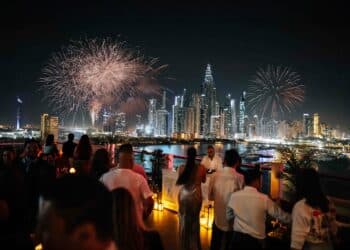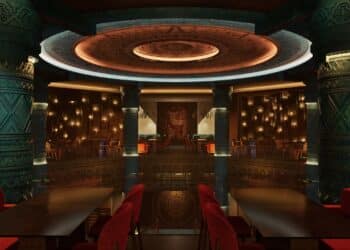For the Sultanate of Oman, 2015 was an outstanding year for tourism. Record visitor numbers and media coverage are reflective of the increasing tourism profile of the Sultanate, which is seeking to outgrown its status as a niche, luxury destination. While there are clear benefits of this, Hotel News ME investigates what key decisions must be made now to ensure continued success in the future.

2015 proved to be a record year for Oman’s tourism industry, with the number of incoming visitors topping those of previous years. The preservation of the country’s natural surroundings and cultural traditions has allowed it to keep much of the spirit of “old Arabia”, and indeed tourism has been deliberately kept at the high end, with marketing aimed at visitors who are interested in engaging with local culture, nature and history. Meanwhile, various developments look set to bolster the sector moving forward, with the ongoing expansion of Muscat International Airport a prime example. A new terminal is currently under construction which will boast an expected capacity of 12 million passengers per annum, with further capacity to accommodate four times that number in the future.
Despite falling oil prices and rising regional uncertainty, which led to extra caution among many consumers and businesses, numbers for the sector in 2015 are extremely healthy, growing on the back of a very strong year in 2014. Oman’s main tourism gateway is Muscat International Airport (MIA), formerly Seeb International Airport, which is conveniently located just 32 km from the centre of the capital. Figures from the National Centre for Statistics and Information (NCSI) for the first seven months of 2015 show a total of 5.21 million passengers passing through MIA on international flights, plus 499,553 more on domestic flights. Both figures are substantially up on the first seven months of 2014, when the respective numbers were 4.65 million and 454,079 with this growth representing a Y-o-Y increase of around 12% in international and 10% in domestic passenger number.
Omani hospitality
Visitors arriving to the Sultanate of Oman are often struck not only by the beauty of their surroundings, but also the hospitality of the Omani people. As exemplified by the good relations between its religious and ethnic groups, the Sultanate is renowned for its tolerant attitudes.
The preservation of the country’s natural surroundings and cultural traditions has allowed it to keep much of the spirit of ‘old Arabia’ with tourism being deliberately kept at the high end, with marketing aimed at visitors who are interested in engaging with the local culture, nature and history.
Muscat offers forts and museums, as well as business and entertainment venues, while the north of the country presents opportunities for adventure holidays, such as the stark, craggy peaks of Musandam or the Hajar Mountains. The ancient capital of Oman, Nizwa, is rich in historical and cultural highlights, and was selected as ‘Capital of Islamic Culture in the Arab Region’ in 2015, while further south, the Wahiba Sands present desert landscapes and the offshore island of Masirah, known for its marine wildlife.
Salalah is also a vibrant city with fine beaches, while inland, the Jebel Akhtar Mountains come to life during the khareef period. Each of these areas offers the potential for the clustering of sights and activities, an approach that is becoming increasingly popular with tour organisers.
Ensuring that this level of continuity exists in visitor experience and tourist infrastructure throughout the country is still a work in progress. This is an area that usually calls for large private sector involvement, though the sector is currently being steered by public bodies. Omran, a public sector entity, is responsible for around 30% of the country’s available and projected hotel room numbers. Oman Air, the state-owned airline, consistently ranks as the nation’s most popular carrier for domestic flights and is still expanding its capacity.
Expanding Airports
Meanwhile, at Salalah in the southern governorate of Dhofar, the country’s second major flight destination also saw an increase in passenger numbers. Between the old Salalah Airport and the newly opened Salalah International Airport (SAIA), the total international passenger throughput was 178,855 in the first seven months of 2015, up from 131,786 in the same period the year before. Domestic numbers rose from 319,132 to 360,204, giving respective percentage increases of 35.7% and 12.7%. Both MIA and SAIA are managed and operated by government-owned Oman Airports Management Company (OAMC). A new terminal for MIA is currently under construction, with an expected capacity of 12 million passengers per annum and further potential to accommodate up to four times that number. The expansion project includes an extension of the existing runway to 4km, plus a 4 km runway at the new terminal too. This will mean a future airport with two runways each capable of handling Airbus A380s, the largest passenger jet currently in operation by Emirates. The new terminal will also have around 18,000 sq. metres of commercial space, with tenders for duty free, luxury retail concessions and F&B contracts issued in August 2015 with the expanded airport set to open in 2017.
Meanwhile, SAIA, saw its new venue open in June 2015 and the $776.7 million project has seen the construction of a terminal capable of handling one million passengers per year, with future expansion plans to extend the capacity to six million passengers per year
Looking to hotel guest numbers and occupancy rates, the most recent NCSI data for establishments in the three- to five-star range for the January-May 2015 period is useful. This data shows that numbers were down, year-on-year, during these five months, from 516,962 in January-May 2014 to 516,481 in the same period of 2015.
Source Markets
The Sultanate has seen some significant improvements in certain national groups, broadly reflective of global economic trends, as Western markets have now recovered while emerging markets have faced challenging times. The number of hotel guests from Europe went up from 161,081 in January-May 2014 to 185,940 in the first five months of 2015, while the number of American guests also rose, from 17,548 to 20,278. The main declines were seen in Asian hotel guests, down from 81,744 to 59,722, and amongst Omanis themselves, down from 159,638 to 149,403. Evident to see from the figures, the European market is the largest source market for business in Oman. With Europeans, like other northern visitors, travelling mostly during their own winter: European hotel guest numbers reached 44,108 in March 2015, for example, falling to 27,072 in May 2015.
A major season for visitors to Salalah and the south is the khareef, which extends from the end of July to the beginning of September, when the Indian Ocean monsoon visits the shores of Dhofar, temporarily turning the coastal plain of the governorate green and providing a welcome respite from soaring temperatures elsewhere in the Gulf. While also attracting visitors from other GCC and Arab countries, this season is particularly popular with Omani visitors. Indeed, NCSI figures recorded that between June 21 and August 31, 2015, 502,089 people visited Dhofar for khareef, an increase on 417,019 at the same point in 2014. Of these, 371,931 were from Oman themselves, constituting 72% of the total visitors, an increase of 17.3% on the same period of the previous year.
Other major entryways to Oman for international visitors include the land border with the UAE which is roughly a four-hour drive between Muscat and Dubai. The latter have all been undergoing a major reorganisation in recent times, with Port Sultan Qaboos (PSQ), previously Muscat’s main commercial port is now dedicated to passenger traffic. Other ports such as Sohar and Salalah also feature on a number of international cruise ship itineraries, as does the port of Khasab in the Musandam exclave, the Omani governorate on the According to Ministry of Transport and Communications (MoTC) figures, the total number of inbound and outbound tourists visiting PSQ in the first five months of 2015 was 239,964, up from 197,786 in January to May 2014. This was a 21% increase, with 64 cruise ships having called at the port during this time period. A new logo and brand identity for the port are in development, hoping to consolidate momentum from the 2014 formation of Cruise Arabia, which partners with bodies in Qatar, Dubai and Abu Dhabi to promote cruise tourism in the Gulf.
A key contender
According to data from the World Travel and Tourism Council (WTTC), the direct contribution to GDP by the tourism sector in Oman was a total of $2bn, or in percentage terms, 2.6%, in 2014. However, when indirect contributions are taken into account, the figure rises to $4.4bn – 5.7% of GDP. Both these figures show steady Y-o-Y growth since the start of the decade, and the WTTC predicts that direct contributions will continue to grow by around 6.1% per year through to 2025, while indirect contributions will grow some 6.2%. By 2025, this would give the sector a direct GDP contribution of 3.3% of GDP and an indirect contribution of 7.3%.
Another major incentive behind the development of a new strategy for tourism stems from job provisions – Oman has a young population with 20% under the age of 25, and there is a growing need to create jobs. Tourism has been identified as a sector that could be a source of significant employment, the WTTC estimates that in 2014, 44,500 jobs were directly generated by the sector, representing 2.8% of total employment, and when indirect employment estimates are factored in, the number swells to 90,500 of total employment. The WTTC also forecasts that by 2025, tourism will account for 72,000 jobs directly and 143,000 jobs indirectly, an annual increase of some 3.8% on both counts. The new strategy for tourism will place a major emphasis on promoting Oman as a destination to international visitors. The figures show how important foreign visitor expenditure is to the sector and to its growing contribution to GDP. The WTTC calculated that in 2014, foreign spending generated 60.7% of the sector’s contribution to national wealth, with domestic tourists accounting for the remainder. With the help of the 2015-2040 strategy, foreign spending is forecast to grow by 7.1% per year, up to 2025, with domestic spending to grow by around 3.9%, representing a new avenue for growth in the Omani tourism sector.
Oman Air
The national carrier, Oman Air, was established in 1993, operating its first domestic flights from Muscat to Salalah and its first international route from Muscat to Dubai. In 2007, with the government announcing plans to pull out of its Gulf Air contract – the joint venture airline it had formerly shared with Abu Dhabi, Bahrain and Qatar, and fundamentally increasing its stake in Oman Air.
A major expansion in routes and planes followed, along with a steady increase in the government’s stake, with this now standing at 99.825%. Data in the airline’s 2014 annual report shows that it carried more than 5.1 million passengers in with 23,500 round trips and had a capacity of 15.2bn available seats. The airline also reveals in the annual report that it made a contribution of $1.1bn to the Sultanate’s GDP in 2014.
Oman Air’s fleet stood at 32 aircrafts in 2014, but a new development plan, that began in 2013 will see the airline investing in more narrow, and wide-bodied aircrafts. The 2020 target is for a fleet of 25 wide-body and 45 narrow-body planes with Oman Air currently boasting nine codeshare partnerships, giving it access to a total of 56 global destinations.
The future may be a more competitive one for the airline, as in May 2015, Oman’s aviation sector regulator, the Public Authority for Civil Aviation, began a request for information process to test market interest in establishing a low-cost carrier that would compete with the airline. Such a newcomer would face an Oman Air that has increased its share of departure capacity from the sultanate’s airports from 24.7% in 2006 to 55% today, with capacity predicted to grow by 15.9% for 2016. Nonetheless, with the total capacity of Oman’s airports increasing by some 88.8% between 2005 and 2014 – an annual average growth rate of 9.9% and capacity at Muscat and Salalah due to rise 16.9% and 12.3%, respectively, there is likely to be enough space to go around.
Looking ahead
Encouraging more private sector involvement is likely to be a target in the country’s new 2040 tourism plan, with the sector potentially looking to fill in its destination management gaps through public and private investment, in order to improve the overall travel experiences for tourist. With the debate rife, over whether Oman should move its focus away from higher-end tourism to a more mass-market approach. Certainly, the region is not standing still on this, with Dubai already attracting a reputation as a mass tourism destination and other Gulf countries anxious to promote themselves, too. At the same time, achieving a balance between preserving what makes Oman special and generating a bigger contribution to GDP through diversification will require further careful planning and a thoughtful rollout process from both the public and private sector, but in the shorter term, much will depend on the fortunes of the oil price in the year ahead, in terms of regional investor sentiment, along with the fate of the global economy at a time of renewed concerns over growth. Regional political instability will also be a factor – although there may be a strong upside, if Iran begins to move out of its current isolation. For Oman too, the overall fundamentals remain strong, with today’s major investments in infrastructure likely to pay off in the medium to longer term, with some benefits already visible.


































































